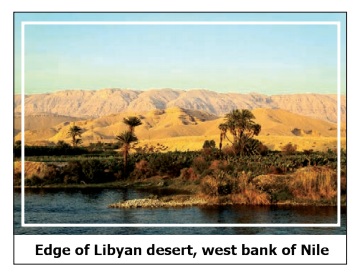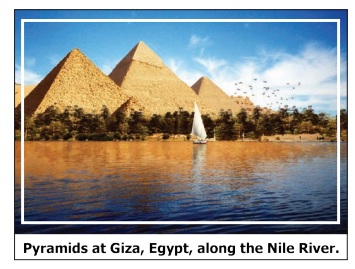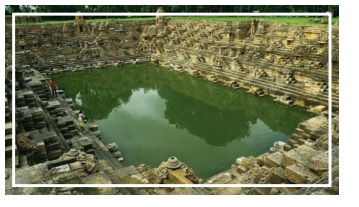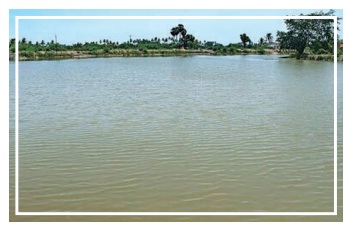by Sir C.V. Raman | English Prose - Water - The Elixir of Life | 9th English : UNIT 5 : Prose : Water - The Elixir of Life - by Sir C.V. Raman
Chapter: 9th English : UNIT 5 : Prose : Water - The Elixir of Life - by Sir C.V. Raman
Water - The Elixir of Life
Prose
Water – The Elixir of Life
Sir C.V. Raman
Now read the lesson "Water–The Elixir of Life", on the
importance of water, an important natural resource.
Man has through the ages sought in vain for an
imaginary elixir of life, the divine Amrita,
a draught of which was thought to confer immortality. But the true elixir of
life lies near our hands; for it is the commonest of all liquids, plain water!
I remember one day standing on the line which separates the Libyan Desert from
the Valley of the Nile in Egypt.

On one side was visible a sea of billowing sand without a
speck of green or a single living thing anywhere on it. On the other side
lay one of the greatest, most fertile and densely populated areas to be
found anywhere on the earth, teeming with life and vegetation. What made this wonderful
difference? Why, it is the water of the river Nile flowing down to the
Mediterranean from its sources a couple of thousands of miles away.

Geologists tell us that the entire
soil of the Nile valley is the creation of the river itself, brought down as
the finest silt in its flood
waters, from the highlands of Abyssinia and from remote Central Africa, and
laid down through the ages in the trough through which the Nile flows into the
sea. Egypt, in fact, was made by its river. Its ancient civilization was
created and is sustained by the life-giving waters which come down year after
year with unfailing regularity.
* What is the imaginary elixir of
life?
Divine
Amritha is the imaginary elixir of life.
* What according to the writer is
the real elixir of life?
According
to the writer, water is the real elixir of life.
* What is the ‘wonderful
difference’ the writer talks about in the
passage?
The
Libyan desert lies with a sea of billowing sand. While the valley of the Nile
in Egypt, which lies next to it is teeming with life and vegetation. The writer
talks about this wonderful difference.
I give this example and could give many others
to emphasis that this common substance which we take for granted in our
everyday life is the most potent and the most wonderful thing on the face of
our earth. It has played a role of vast significance in shaping the course of
the earth’s history and continues to play the leading role in the drama of life
on the surface of our planet.
There is nothing which adds so much to the
beauty of the countryside as water, be it just a little stream trickling over the rocks or a little pond by the
wayside, where the cattle quench their thirst of an evening.

The rainfed tanks that are so common in South
India – Alas! often so sadly neglected in their maintenance – are a cheering
sight when they are full. They are, of course, shallow, but this is less
evident since the water is silt-laden and throws the light back, and the bottom
does not therefore show up. These tanks play a vital role in South Indian
agriculture. Some of these tanks are surprisingly large and it is a beautiful
sight to see the sun rise or set over one of them. Water in a landscape may be
compared to the eyes in a human face. It reflects the mood of the hour, being
bright and gay when the sun shines, turning to dark and gloomy when the sky is
overcast.

* What is the ‘cheering sight’ mentioned in the paragraph?
The
rain fed tanks which are full is the 'cheering sight' mentioned in this
paragraph.
* What does the writer compare
water in a landscape to?
The
writer compares water in a landscape to the eyes in a human face.
One of the most remarkable facts about water is
its power to carry silt or finely divided soil in suspension. This is the
origin of the characteristic colour of the water in rainfed tanks. This colour
varies with the nature of the earth in the catchment
area and is most vivid immediately after a fresh inflow following rain. Swiftly
flowing water can carry fairly large and heavy particles. The finest particles,
however, remain floating within the liquid in spite of their greater density
and are carried to great distances. Such particles are, of course, extremely
small, but their number is also great and incredibly large amounts of solid
matter can be transported in this way.
When silt-laden water mixes with the salt water
of the sea, there is rapid precipitation of the suspended matter.
This can be readily seen when one travels by
steamer down a great river to the deep sea. The colour of the water changes
successively from the muddy red or brown of silt through varying shades of
yellow and green finally to the blue of the deep sea. That great tracts of land
have been formed by silt thus deposited is evident on an examination of the
soil in alluvial areas. Such land, consisting as it does of finely divided
matter, is usually very fertile.
How does the water in rainfed
tanks get its colour?
The
water in rainfed tanks gets its colour from the suspended finely divided soil
in it.
The flow of water has undoubtedly played a
great part and a beneficent one in the geological processes by which the soil
on the earth’s surface has been formed from the rocks of its crust. The same agency, however, under appropriate
conditions, can also play a destructive part and wash away the soil which is
the foundation of all agriculture, and if allowed to proceed unchecked can have
the most disastrous effect on the life of the country. The problem of soil
erosion is one of serious import in various countries and especially in many
parts of India. The conditions under which it occurs and the measures by which
it can be checked are deserving of the closest study .
Soil erosion occurs in successive steps, the
earliest of which may easily pass unnoticed. In the later stages, the cutting
up and washing away of the earth is only too painfully apparent in the
formation of deep gullies and ravines which make all agriculture impossible.
Sudden bursts of excessively heavy rain resulting in a large run of surplus
water are the principal factors in causing soil erosion. Contributory causes
are the slope of the land, removal of the natural protective coat of
vegetation, the existence of ruts along which the water can flow with rapidly
gathering momentum, and the absence of any checks of such flow. Incredibly
large quantities of precious soil can be washed away if such conditions exist,
as is too often the case.
* What is the main cause of soil erosion?
Sudden
bursts of heavy rains result in large run of surplus water. This is the main
cause of soil erosion.
* What other factors add to the erosion of precious soil?
The
slope of the land, the removal of vegetation, water flowing along ruts and the
absence of any checks to such flow add to the erosion of precious soil.
The menace which soil erosion presents to the
continuance of successful agriculture is an alarming one in many parts of
India, calling urgently for attention and preventive action. The terracing of
land, construction of bunds to check the flow of water, the practice of contour
cultivation and the planting of appropriate types of vegetation are amongst the
measure that have been suggested. It is obvious that the aim should be to check
the flow of water at the earliest possible stage before it has acquired any
appreciable momentum and correspondingly large destructive power.
* How can soil erosion be
prevented?
Soil erosion can be prevented by: i) terracing of land ii) construction of bunds to check the flow of water iii)the practice of contour cultivation iv.) the planting of appropriate types of vegetation.
Water is the basis of all life. Every animal or
plant contains a substantial proportion of free or combined water in its body,
and no kind of physiological activity is possible in which the fluid does not
play an essential part. Water is, of course, necessary for animal life, while
moisture in the soil is equally imperative for the life and growth of plants
and trees though the quantity necessary varies enormously with the species. The
conservation and utilization of water is thus fundamental for human welfare.
Apart from artesian water the ultimate source in all cases is rain or snowfall.
Much of Indian agriculture depends on seasonal rainfall and is therefore very
sensitive to any failure or irregularity of the same. The problems of soil
erosion and of inadequate or irregular rainfall are closely connected with each
other. It is clear that the adoption of techniques preventing soil erosion
would also help to conserve and keep the water where it is wanted, in other
words, on and in the soil, and such techniques therefore serve a double
purpose.
* How does prevention of soil
erosion serve a double purpose?
Prevention
of soil erosion will save the soil and help to conserve and keep the water
where it is wanted.
* What are the two sources of
water?
Artesian
and rain water or snow fall are the two sources of water.
It is evident, however, that in a country
having only a seasonal rainfall, an immense quantity of rain-water must
necessarily run off the ground. The collection and utilization of this water
is, therefore, of vital importance. Much of it flows down into the streams and
rivers and ultimately finds its way to the sea. Incredibly large quantities of
the precious fluid are thus lost to the country. The harnessing of our rivers,
the waters of which now mostly run to waste, is a great national problem which
must be considered and dealt with on national lines. Vast areas of land which
at present are mere scrub jungle could be turned into fertile and prosperous
country by courageous and well-planned action.
* What happens to
the rain water?
Much
of the rain water runs off the ground. It flows into streams and rivers and
ends up in the sea.

Closely connected with the conservation of
water supplies is the problem of afforestation. The systematic planting of
suitable trees in every possible or even in impossible areas, and the
development of what one can call civilized forests, as distinguished from wild
and untamed jungle, is one of the most urgent needs of India. Such plantation
would directly and indirectly prove a source of untold wealth to the country.
They would check soil erosion and conserve the rainfall of the country from
flowing away to waste, and would provide the necessary supplies of cheap fuel,
and thus render unnecessary the wasteful conversion of farmyard manure into a
form of fuel.
* What is the idea of civilized
forest?
The
systematic planting of suitable trees in every possible and impossible area is
called civilized forest.
* How can you check soil erosion?
Afforestation
would check soil erosion.
The measures necessary to control the movement
of water and conserve the supplies of it can also serve subsidiary purposes of
value to the life of the countryside. By far the cheapest form of internal
transport in a country is by boats and barges
through canals and rivers. We hear much about programmes of rails and road
construction, but far too little about the development of internal waterways in
India. Then, again the harnessing of water supplies usually also makes possible
the development of hydro-electric power. The availability of electric power
would make a tremendous difference to the life of the countryside and enable
rural economy to be improved in various directions.
* What is the cheapest means of transport?
The
cheapest means of transport is by boats.
* How can you make a difference
in the countryside?
We
can make a difference in the country side by the availability of electric
power.
In one sense, water is the commonest of
liquids. In another sense, it is the most uncommon of liquids with amazing
properties which are responsible for its unique power of maintaining animal and
plant life. The investigation of the nature and properties of water is,
therefore, of the highest scientific interest and is far from an exhausted field
of research.
Do you know?

The Great Pacific Garbage Patch
* It is the world’s largest
collection of floating trash.
* It is in the Pacific Ocean
between Hawaii and California and is often described as “larger than
Texas”
* Approximately 7 million tons of plastic and other debris up to 9 feet deep are floating.
* By estimation 80% of the
plastic originates from land; floating in rivers to the ocean and the
remaining 20% of the plastic originates from oil platforms and ships
* These trash piles are the
biggest threat to the sea animals.
About the Author

Sir Chandrasekhara Venkata Raman
(7 November 1888 – 21 November 1970) was an Indian physicist born in
Tiruchirappalli. He carried out ground-breaking work in the field of light
scattering, which earned him the 1930 Nobel Prize for Physics. He discovered
that when light traverses a transparent material, some of the deflected light
changes wavelength. This phenomenon, subsequently known as Raman scattering,
results from the Raman effect and to commemorate it, February-28 is celebrated
as National Science Day. In 1954, India honoured him with its highest civilian
award, the Bharat Ratna.
Related Topics